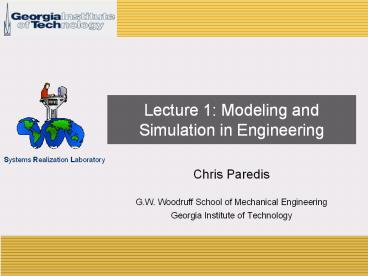Lecture 1: Modeling and Simulation in Engineering - PowerPoint PPT Presentation
1 / 18
Title:
Lecture 1: Modeling and Simulation in Engineering
Description:
Lecture 1: Modeling and Simulation in Engineering Chris Paredis G.W. Woodruff School of Mechanical Engineering Georgia Institute of Technology – PowerPoint PPT presentation
Number of Views:874
Avg rating:3.0/5.0
Title: Lecture 1: Modeling and Simulation in Engineering
1
Lecture 1 Modeling and Simulation in Engineering
- Chris Paredis
- G.W. Woodruff School of Mechanical Engineering
- Georgia Institute of Technology
2
Lecture Overview
- Objective
- Create a framework for the rest of this course
- Frame numerical methods in the context of
engineering design - Topics
- The engineering design process
- The importance of modeling in design
- The importance of numerical methods in creating
and solving models - The use of Matlab in numerical methods
3
Setting the Context
4
What is a Model?
- Examples of types of Models
- Physical (scale) models
- Mental models
- Mathematical models
What do these examples have in common?
- They are abstractions they approximate reality
to some extent - They are surrogates for some other system
- Although they are abstractions, they can convey
some important insight into the physical system
they are modeling
5
Examples of Models in Vehicle Design
Computational Fluid Dynamics
Stress Analysis
6
What is a Model?
- Definition (based on Marvin Minsky's definition)
- A model (M) for a system (S) and an experiment
(E) is anything to which E can be applied in
order to answer questions about S - A model is an abstraction of reality
Who has create a new model today?
7
How Does Modeling Relate to Knowledge?
A Model is Knowledge!
- "Modeling means the process of organizing
knowledge about a given system" (Bernard Zeigler) - Models allow us to
- Predict
- Infer new information
8
A Quick AsideWhen is a Model Valid?
- Is this model valid?
f(x)
x
9
Unanticipated Phenomena May Invalidate Model
Tacoma Narrows Bridge, Nov 7, 1940.
10
Overview of Presentation
- What is a Model?
- Creating Models Scientific Research
- Some Model Characteristics
- Using Models in Engineering
11
Using Models Simulation?
- Definition of Simulation
- A simulation is an experiment performed on a
model - (Korn and Wait)
- Simulation requires
- A model description
- An experiment description
- Most often, simulation refers to mathematical
models evaluated (exercised) on a computer
12
Why is Simulation Important in Engineering?
Satisficing Solution
Initial Guess
Decision Solver
Predict theOutcome of Engineering Design
Decisions
DesignAlternative
Evaluation ofDesign Alternative
13
When is Simulation most useful?
- When the system is not available
- When the physical experiments cannot be performed
- When the cost of experimentation is too high
- When the time scale of the system is not
compatible with those of the experimenter - Under controlled circumstance (e.g. no
disturbances)
14
Examples of Models in Vehicle Design
Computational Fluid Dynamics
Stress Analysis
15
Manufacturing Simulation
- DFM DFA DFX
- Take life cycle cost into account at the design
stage
16
Training Simulators
- Use the previously developed simulation models
for training - Train operators before prototypes are built
- Test whether user interface is user-friendly
17
Immersive Environments
- Allow user to interact with models through
- 3-dimensional vision
- Touch (tactile interface)
- Complete virtual prototype
18
If a picture is worth 1000 words,how about a
simulation?
- Summary
- We all create and use models all the time
- In science, models are formalized and validated
- In engineering, models are used for evaluation,
training, documentation.































